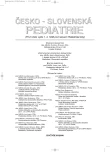Examination Procedure in the Child with Proteinuria
Authors:
Ľ. Podracká 1; L. Kovács 2
Authors‘ workplace:
I. Klinika detí a dorastu LF UPJŠ a DFN, Košice
prednostka prof. MUDr. Ľ. Podracká, CSc.
1; 2. Detská klinika LFUK a DFNsP, Bratislava
prednosta prof. MUDr. L. Kovács, DrSc., MPH
2
Published in:
Čes-slov Pediat 2008; 63 (6): 327-335.
Category:
Postgraduate Education
Overview
Proteinuria is a common urinary syndrome occurring in clinical pediatric practice. Proteinuria may be transient and/or persistent resulting from a glomerular and/or tubular origin. A total urine protein measurement as well as type of proteinuria should be determined before any other specific investigations are undertaken.
The dilemma that faces the pediatrician is to recognize whether the child should be referred to a pediatric nephrologist. The early decision is very important, since its might prevent and/or postpone the irreversible kidney damage.
Key words:
proteinuria, glomerular proteinuria, tubular proteinuria, determination of urinary protein, diagnostic algorithm
Sources
1. Vehaskari VM, Rapola J. Isolated proteinuria: analysis of a school-age population. J. Pediatr. 1982;101: 661–668.
2. Dodge WF, West EF, Smith EH, Bunce Harvey 3rd. Proteinuria and hematuria in school-age children: epidemiology and early natural history. J. Pediatr. 1976;88: 327–347.
3. Yoshikawa N, Kitagawa K, Ohta K, Tanaka R, Nakamura H. Asymptomatic constant isolated proteinuria in children. J. Pediatr. 1991;119: 375–379.
4. Burton C, Harris KPG. The role of proteinuria in the progression of chronic renal failure. Am. J. Kidney Dis. 1996;27: 765–775.
5. Šašinka M. Proteinúria. In Dzúrik M, Šašinka M, Mydlík M, Kovács L. Nefrológia. Bratislava: Herba, 2004: 87–96.
6. Johnstone DB, Holzman LB. Clinical impact of research on the podocyte slit diaphragm. Nat. Clin. Pract. Nephrol. 2006;2(5): 271–282.
7. Ehrich JHH, Miltenyi M. Proteinuria. In Cochat, P. ESPN Handbook. France, 2002: 88–95.
8. Ritz E. Renal dysfunction as a novel risk factor: Microalbuminuria and cardiovascular risk. Kidney Int. 2005;67(Suppl 93): S25–S28.
9. Bergstein JM. A practical approach to proteinuria. Pediatr. Nephrol. 1999;13: 697–700.
10. Houser M. Assessment of proteinuria using random urine samples. J. Pediatr. 1984;104(6): 845–848.
11. Dubayová K, Kušnír J, Podracká Ľ. Diagnostic monitoring of urine by means of synchronous fluorescence spectrum. J. Biochem. Biophys. Methods 2003;55(2): 111–119.
12. Podracká Ľ, Šašinka M, Kováčová A, Böör A, Filka J. Lyzozymúria – jednoduchá metóda na dôkaz tubulointersticiálneho poškodenia obličiek. Detský Lekár 1994;1(4): 149–150.
13. Gagnadoux MF. Evaluation of proteinuria in children. UpToDate 2005;3: 2.
14. Rose BD, Fletcher SW. Proteinuria: The primary care approach. UpToDate 2007.
15. Trachtman H, Bergwerk A, Gauthier B. Isolated proteinuria in children. Natural history and indications for renal biopsy. Clin. Pediatr. 1994;33: 468–472.
16. Springberg PD, Garrett LEJr, Thompson AL, Collins NF, Lordon RE, Robinson RR. Fixed and reproducible orthostatic proteinuria: results of a 20-year follow-up study. Ann. Intern. Med. 1982;97: 516–519.
17. Voght BA, Avner ED. Conditions particulary associated with proteinuria. In Nelson Textbook of Pediatrics. 17th ed. Philadelphia: W. B. Saunders, 2004: 1751–1753.
18. Ruggenenti P, Perna A, Mosconi L, Pisoni R, Remuzzin G. Urinary protein excretion rate is the best independent predictor of ESRF in non-diabetic proteinuric chronic nephropathies. Kidney Int. 1998;53: 1209–1216.
19. Ihle BU, Whitworth JA, Shahinfar S, Cnaan A, Kincaid-Smith PS, Becker GJ. Angiotensin-converting enzyme inhibition in nondiabetic progressive renal insufficiency: a controlled double-blind trial. Am. J. Kidney Dis. 1996;27: 489–495.
20. Zoja C, Donadelli R, Colleoni S, Figliuzzi M, Bonazzola S, Morigi M, Remuzzi G. Protein overload stimulates RANTES production by proximal tubular cells depending on NF-kB activation. Kidney Int. 1998;53: 1608–1615.
21. Ryšavá R, Tesař V, Merta M. Nefrotický syndróm. Interní Medicína pro Praxi 2005;3: 131–134.
22. Hogg RJ, Portman RJ, Milliner D, et al. Evaluation and management of proteinuria and nephrotic syndrome in children: Recommendations from a Pediatric Nephrology panel established at the National Kidney Foundation Conference on Proteinuria, Albuminuria, Risk, Assessment, Detection and Elimination (PARADE). Pediatrics 2000;105: 1242.
23. Trachtman H, Bergwerk A, Gauthier B. Isolated proteinuria in children. Natural history and indications for renal biopsy. Clin. Pediatr. 1994;33: 468–472.
24. Yoshikawa N, Kitagawa K, Ohta K, Tanaka R, Nakamura H. Asymptomatic constant isolated proteinuria in children. J. Pediatr. 1991;119: 375–379.
25. Jafar TH, Stark PC, Schmid CH, et al. AIPRD Study Group. Progression of chronic kidney disease: The role of blood pressure control, proteinuria, and angiotensin-converting enzyme inhibition-A patient-level meta analysis. Ann. Intern. Med. 2003;139: 244–252.
26. Barclay L. ACE inhibitors may slow progression of IgA renal disease. Am. Soc. Nephrol. 2007;18: 1880–1888.
27. Šašinka M, Podracká Ľ, Boor A, Jurkovič I, Mitro A, Kovács L. Enalapril treatment of proteinuria in normotensive children. Bratisl. lek. Listy 1999;100(9): 476–480.
28. Bhattacharjee R, Filler G. Additive antiproteinuric effect of ACE inhibitor and losartan in IgA nephropathy. Pediat. Nephrol. 2002;17(4): 302–304.
29. Seeman T, Patzer L, John U, Dusek J, Vondrák K, Janda J, Misselwitz J. Blood pressure, renal function, and proteinuria in children with unilateral renal agenesis. Kidney Blood Press. Res. 2006;29(4): 210–215.
Labels
Neonatology Paediatrics General practitioner for children and adolescentsArticle was published in
Czech-Slovak Pediatrics

2008 Issue 6
Most read in this issue
- Examination Procedure in the Child with Proteinuria
- Intrauterine Growth Retardation and Fetal Origin of Diseases at the Adult Age
- Therapy of Inborn Spine Deformities
- Spinal Epidural Abscess in a Sixteen Years Old Boy Case report and review of literature
